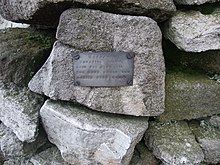| Priest's Tarn | |
|---|---|
 Priest's Tarn on Grassington Moor Priest's Tarn on Grassington Moor | |
 | |
| Location | Grassington Moor, North Yorkshire |
| Coordinates | 54°07′16″N 1°57′32″W / 54.121°N 1.959°W / 54.121; -1.959 |
| Primary outflows | Crag Grainings Blea Beck |
| Basin countries | England |
| Surface area | 1-hectare (2.5-acre) |
| Surface elevation | 516.5 metres (1,695 ft) |
| References | |
Priest's Tarn is an upland lake on Grassington Moor, in North Yorkshire, England. The water from Priest's Tarn was historically used for hydraulic mining purposes during the lead industry on Grassington Moor. The flow of water largely exits the hill to the south-east into Grimwith Reservoir, which in turn feeds into the River Wharfe. Walkers have observed that the tarn is looking like it is drying up.
Description

Water exiting from Priest's Tarn flows south firstly through Crag Grainings and then into Blea Beck. Water was canalised here to feed the dams of the Grassington Moor lead industry. The water flows to Grimwith Reservoir, some 5.3 kilometres (3.3 mi) to the south-east of the tarn, which feeds into the River Wharfe.
Walkers who have navigated to the tarn, state that it has largely dried up in comparison to the expanse shown on Ordnance Survey maps. The average annual rainfall between 1916 and 1955 was 1,549 millimetres (61 in), and between 1941 and 1970, it was 1,501 millimetres (59.1 in).
Stones from the tarn were taken to a point a few hundred metres to the south-west of the tarn to build a memorial cairn for those who died in the Mossdale Cavern tragedy of 1967. The cairn marks the spot above ground where the bodies of six cavers were found after they had drowned in a flash flood underground. Priest's Tarn sits atop the Black Keld Catchment SSSI; one of the largest and deepest cave drainage systems in England.
The western boundary of the civil parish of Grassington goes through the north-west of the tarn, and access to the tarn is via many paths in the area. One of the beds of sandstone on Grassington Moor has been named Priest's Tarn Grit. The etymology of the name of the tarn is unsure, having been recorded in its earliest form in 1717.
Rainfall
Meteorological table are available online from the UK Meteorological office. A selection of the results for Priest's Tarn are given below.
| Year | Rainfall (annual) | Ref |
|---|---|---|
| 1966 | 1,731 millimetres (68.1 in) | |
| 1967 | 1,777 millimetres (70 in) | |
| 1968 | 1,642 millimetres (64.6 in) | |
| 1969 | 1,323 millimetres (52.1 in) | |
| 1973 | 1,256 millimetres (49.4 in) |
References
- "Priest's Tarn, Craven". getoutside.ordnancesurvey.co.uk. Retrieved 4 June 2022.
- "Priests Tarn Water Body ID 29804". eip.ceh.ac.uk. Retrieved 4 June 2022.
- "The Mine workings of Grassington". www.northcravenheritage.org.uk. Retrieved 4 June 2022.
- "DALES AREA FRESHWATER RIVERS AND CANALS RIVER REACH CLASSIFICATION SUMMARY 1990-9" (PDF). ea-lit.freshwaterlife.org. Environment Agency. July 1999. p. 26. Retrieved 4 June 2022.
- "Priest's Tarn | Lakes & Tarns". My Yorkshire Dales. Retrieved 4 June 2022.
- "View map: SE06 - D/ (includes: Appletreewick; Grassington; Hartlington; Hebden) - Ordnance Survey 1:25,000 maps of Great Britain, 1945-1969". maps.nls.uk. Retrieved 8 July 2022.
- ^ Monthly and Annual Totals of Rainfall 1969 for the United Kingdom. Bracknell: Meteorological Office. 1979. p. 5. ISBN 0-86180-021-4.
- ^ Monthly and Annual Totals Of Rainfall 1973 For the United Kingdom. Bracknell: Meteorological Office. 1981. p. 6. ISBN 0-86180-047-8.
- Brook, Alan. "Building the Mossdale Cairn". In Melvin, Michael (ed.). The Mossdale Tragedy 1967 (PDF). p. 60. Retrieved 4 June 2022 – via michaelmelvin.co.uk.
- "Black Keld Catchment Area" (PDF). designatedsites.naturalengland.org.uk. Retrieved 8 July 2022.
- "Magic Map Application". magic.defra.gov.uk. Retrieved 8 July 2022.
- "Grassington CP". www.ordnancesurvey.co.uk. Retrieved 4 June 2022.
- "OL2" (Map). Yorkshire Dales - Southern & Western Area. 1:25,000. Explorer. Ordnance Survey. 2016. ISBN 978-0-319-26331-0.
- Thompson, A. (1957). The structure and stratigraphy of Nidderdale between Lofthouse and Dacre (Thesis). Durham: University of Durham. p. 29. OCLC 757133510.
- "Priest's Tarn :: Survey of English Place-Names". epns.nottingham.ac.uk. Retrieved 8 July 2022.
- "British rainfall 1966". British Rainfall. 106. London: HMSO: 11. 1973. ISBN 0-11-400209-6. OCLC 655832175.
- British rainfall 1967 Volume 107. London: HMSO. 1973. p. 11. ISBN 0-11-400250-9.
- British rainfall 1968 Volume 108. London: HMSO. 1974. p. 11. ISBN 0-11-400279-7.
External links
| Lakes in Yorkshire | ||
|---|---|---|
| East Riding of Yorkshire |  | |
| North Yorkshire | ||
| South Yorkshire | ||
| West Yorkshire | ||
| Related articles | ||
| Notes |
| |